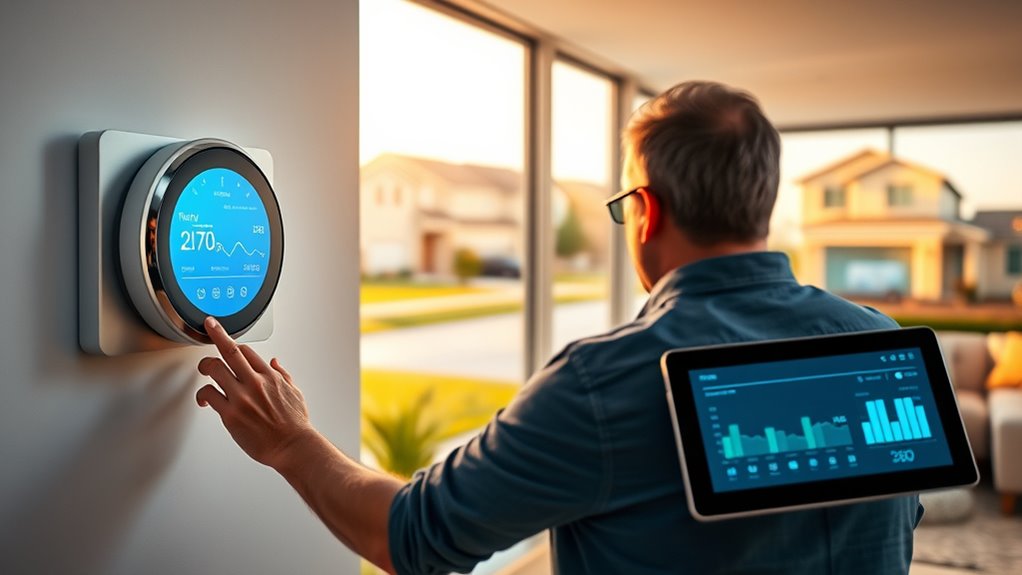Demand response means you can help stabilize the grid during peak times by adjusting your energy use, like running appliances later or reducing consumption. Utility programs often reward you with bill credits, rebates, or lower rates when you participate. By connecting your home’s smart devices with the grid, you can easily respond to signals without sacrificing comfort. Want to discover how your home can benefit from these programs and play a part in a cleaner, more reliable energy future?
Key Takeaways
- Homeowners can reduce energy bills by participating in demand response programs through flexible energy use.
- Automated smart devices enable seamless, temporary adjustments during peak demand without sacrificing comfort.
- Incentives like rebates and bill credits motivate homeowners to lower or shift energy consumption.
- Demand response supports grid stability and enhances integration of renewable energy sources.
- Participating homeowners help create a more reliable, efficient, and environmentally friendly energy system.

Have you ever wondered how electricity providers manage sudden spikes in demand? It’s a clever system called demand response, and it plays a pivotal role in maintaining the stability of the grid. When there’s a surge in consumption—say, during a heatwave or a cold snap—utilities can’t just rely on their usual power sources. Instead, they use demand response programs to encourage homeowners like you to reduce or shift your energy use temporarily. This isn’t about inconvenience; it’s about creating a more efficient, reliable, and resilient energy system.
One of the key ways demand response works is through incentives that motivate you to participate. Energy incentives might include bill credits, rebates, or reduced rates when you agree to lower your energy consumption during peak times. This benefits you by saving money, especially if you’re flexible with your energy use. For example, you might be asked to run your dishwasher or laundry machine during off-peak hours, or to turn off non-essential appliances when demand is highest. These small adjustments help prevent blackouts and reduce the need for utilities to activate costly, fossil-fuel-based backup power plants.
Energy incentives like bill credits and rebates encourage you to reduce usage during peak times, saving money and supporting grid stability.
Smart grid integration is another essential component of demand response. This modern infrastructure connects your home’s energy system with the utility’s grid through advanced communication and automation. When a demand response event is triggered, your smart thermostat, appliances, or energy storage systems can automatically respond, reducing consumption without you lifting a finger. Imagine your smart thermostat lowering your air conditioning slightly during a heatwave, all while maintaining comfort. This seamless coordination makes demand response more effective and less intrusive, ensuring the grid remains balanced with minimal disruption to your daily routine.
By participating in demand response programs, you also contribute to a cleaner environment. When your home adjusts its energy use during peak times, it lessens reliance on fossil-fuel power plants, which often operate less efficiently during high demand. This shift supports the integration of renewable energy sources, like solar and wind, which depend on variable weather conditions and aren’t always available when demand peaks. Smart grid integration makes these renewables more feasible by dynamically balancing supply and demand, reducing emissions, and promoting a sustainable energy future. Understanding how grid stability works can help you appreciate the importance of these programs and your role in the broader energy ecosystem.
In short, demand response isn’t just about curbing usage; it’s about creating a smarter, more adaptable energy system that benefits everyone. As a homeowner, you have an opportunity to earn incentives while helping to stabilize the grid and support clean energy. With smart grid integration, your home becomes an active participant in this system, making energy management more efficient and more aligned with a sustainable future.
Frequently Asked Questions
How Much Can I Save With Demand Response Programs Annually?
You can save around $150 to $300 annually with demand response programs, depending on your energy usage and participation level. These programs offer energy bill savings by reducing consumption during peak times, which also provides participation benefits like incentives or rebates. By adjusting your energy habits during demand response events, you contribute to grid stability and enjoy financial rewards, making it a smart move for savings and environmental impact.
Are There Any Risks to My Home Appliances During Demand Response Events?
During demand response events, your appliances are generally safe, but you should consider appliance safety and compatibility. Some appliances, like smart thermostats or HVAC systems, are designed for these programs and handle temporary power adjustments well. However, older or non-compatible appliances might experience issues or stress. Always check if your devices are compatible with demand response systems, and follow manufacturer guidelines to guarantee your home appliances remain safe during these events.
Can I Opt Out of Demand Response Programs Anytime?
You can usually opt out of demand response programs anytime, but it depends on your utility’s policies and program eligibility. About 60% of homeowners report privacy concerns with these programs, so check your provider’s rules before making a decision. Keep in mind, opting out may limit your ability to benefit from incentives. Contact your utility to understand their specific procedures and make sure you’re comfortable with your choice.
What Equipment Is Necessary to Participate in Demand Response?
To participate in demand response, you need smart thermostats and smart meters. These devices allow your utility to manage your energy use during peak times. Smart thermostats automatically adjust your temperature settings, saving energy and costs, while smart meters provide real-time data on your consumption. With these tools, you can easily respond to demand response signals, helping reduce overall energy strain and potentially earning incentives.
How Do Demand Response Programs Impact My Home’s Energy Consumption Patterns?
Did you know that participating in demand response can cut your energy use during peak hours by up to 15%? When you enroll, you’ll notice your smart thermostat and appliance automation adapt automatically, shifting usage away from high-demand times. This not only lowers your energy bills but also helps reduce grid stress. You gain control over your consumption patterns, making your home more efficient and environmentally friendly.
Conclusion
Now that you understand demand response, you might wonder what’s next. Could your home become a key player in balancing the grid? Will you embrace these changes and access savings or face unforeseen challenges? The future of demand response holds surprises, and your role could be more significant than you think. Stay tuned—what happens next could transform the way you think about energy, your home, and your power to make a difference.










